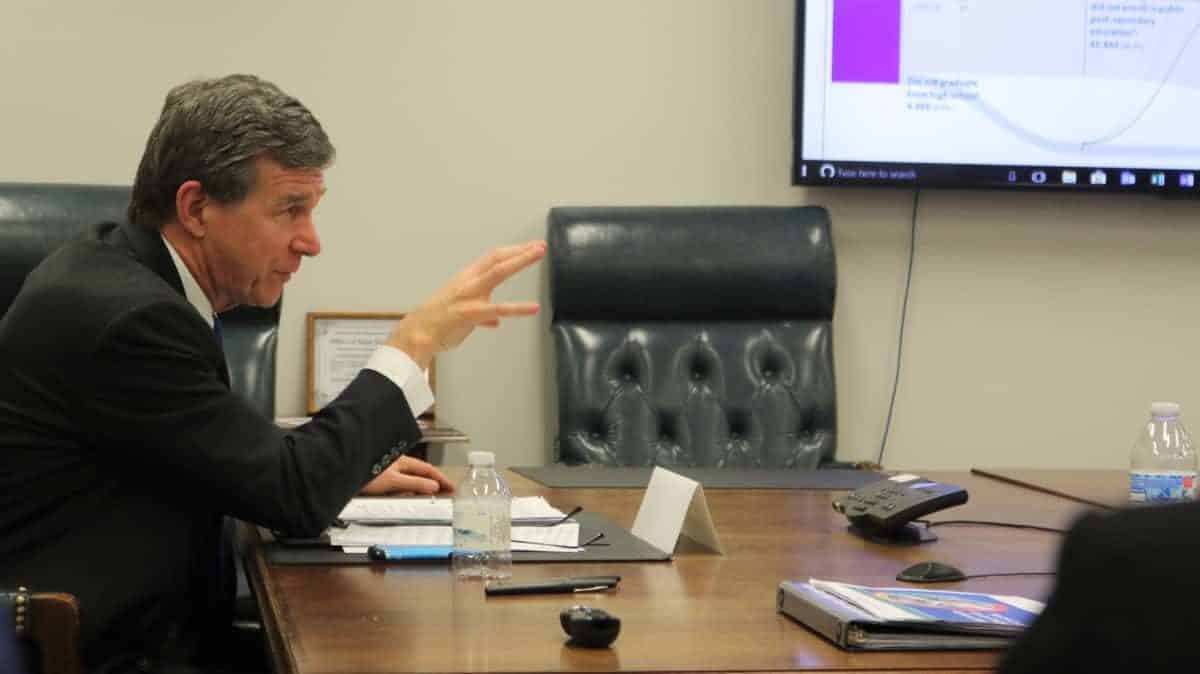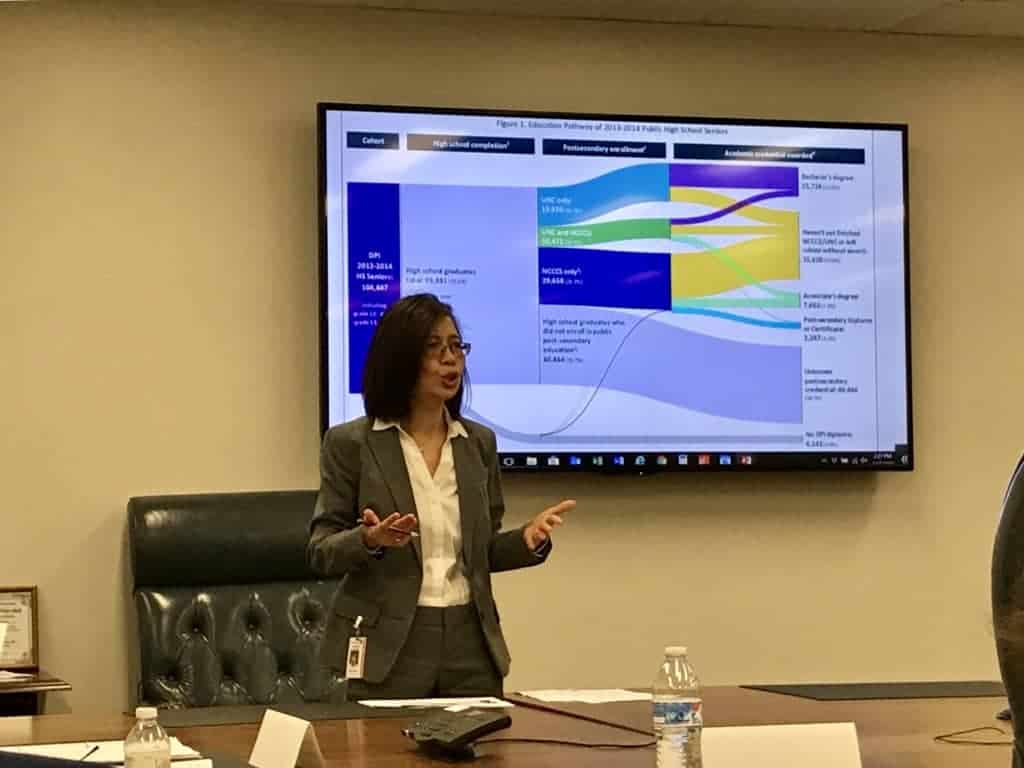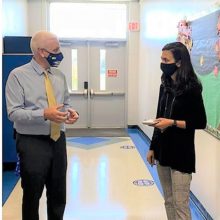
Gov. Roy Cooper’s Education Cabinet convened Wednesday to discuss the status and progress of North Carolina’s education longitudinal data system (ELDS), among other things. Described by the cabinet’s ELDS work group as a “system of systems,” the ELDS is authorized under Chapter 116E of the NC General Statutes and is meant to include individual-level student and workforce data for all levels of education and the workforce system.
The cabinet, created by statute, brings together key stakeholders involved in education from cradle to career to resolve issues between providers of education and to develop and maintain a design for the continuum of education programs. Cabinet members include representatives from the Department of Public Instruction (DPI), the NC Community College System, the UNC System, the NC Independent Colleges and Universities, the NC Department of Health and Human Services (DHHS), the NC Department of Commerce, and the State Board of Education.
What’s the benefit of statewide longitudinal data systems?
By linking student and workforce data over time, formerly-siloed information about students is joined in a seamless manner that tracks how they’re doing from the moment they enter the early childhood system through their workforce outcomes.
Longitudinal data systems allow stakeholders to answer policy questions like: What industries employ the most high school and college graduates? Are ACT scores correlated to workforce salaries? Which students from which schools need remediation classes in higher education? Is participation in NC Pre-K correlated to postsecondary attainment?
A year ago, the cabinet asked the ELDS work group to asses the longitudinal data systems across the education and workforce agencies to determine what was needed to move towards a fully-functioning ELDS. Geoff Coltrane, the governor’s education advisor, said the ELDS work group spent the last year focused on two priorities: 1) studying the policies and statutes that govern the ELDS and assessing the systems that currently exist to determine the best path forward and 2) developing a research question to test the efficacy of the current system.
Policy and governance
On the policy side, the parameters of the statute say that each of the education and workforce systems in the state will contribute data to the ELDS, but the system is administratively housed within DPI and receives staff support from the Government Data Analytics Center (GDAC) housed within the NC Department of Information Technology. There are three main longitudinal data efforts in North Carolina, outlined below.
A primer on the three contributors to the ELDS, all of which are hosted and supported by GDAC:
– NC Early Childhood Integrated Data System (NC ECIDS): This system includes early childhood education, health, and social services data from numerous agencies, including NC Pre-K, Food and Nutrition Services (SNAP), and Child Protective Services. This data system is administered by the NC Department of Health and Human Services.
– NC SchoolWorks (sometimes called P20W or NCSW): This federated data system links data from early learning to workforce, including agencies like DPI, the UNC System, and the NC Community Colleges System. It is administered by the Department of Public Instruction and was first funded by a federal grant in 2012.
– Common Follow-up System (CFS): This system contains postsecondary education and workforce data. Maintained by the NC Department of Commerce’s Labor and Economic Analysis Division, its purpose is to provide information on the educational and employment outcomes of participants in publicly-supported education, employment, and training programs. CFS was developed in 1992 and has since been expanded and enhanced.
“Across those three systems, they each play a vital role for their agencies, and we don’t need to replace any of them. But what we figured out we need to make sure we can do is link those systems up more effectively,” said Coltrane.
To create this “system of systems,” the work group adopted two main strategies.
- Crafting a memorandum of understanding that outlines how each agency in the ELDS will share data with one another. Originally crafted by attorneys from GDAC and DPI, the data sharing agreement has been shared with the other data contributors for their feedback. Coltrane said the goal is to have the agreement signed by each of the agencies by the end of May, allowing the systems to start sharing data more robustly.
- Creating a set of rules that define the ELDS and its components, outline the data request process, and more. These rules were crafted by input from each of the agencies with the facilitation of GDAC and were sent to the Rules Review Commission for approval. Coltrane said he expects the set of rules to be finalized and approved in the next few months.
Testing the data system
To test the functionality of the data system, the work group also posed this research question: What type of journey do North Carolina high school graduates take into and through the community college system, the university system, and the workforce?
After the work group identified the data needed to answer the question, the Labor and Economic Analysis Division at the NC Department of Commerce submitted a data request to the NC SchoolWorks longitudinal data system.
After working through technical challenges, the work group received data on outcomes from three high school graduate cohorts from both NC SchoolWorks and the Common Follow-up System. Data from DPI were matched to the enrollment and completion data from the NC Community College System, the UNC System, and the unemployment insurance wage records to identify post-graduation education and employment outcomes.
“We actually were able to utilize the data system, and once we get these two policy pieces in place, it’ll further strengthen our ability to move forward with that,” said Coltrane.

Meihui Bodane, assistant secretary of policy and research with the Labor and Economic Analysis Division, presented the findings of the pilot research project. Bodane displayed a chart that tracked the various pathways students took from high school completion in 2013-14 through postsecondary enrollment to receiving a postsecondary credential in 2018.
Of the 104,647 high school seniors in the 2013-14 cohort, 95.5% graduated on time. Nineteen percent of that 2013-14 cohort went on to enroll at a UNC System institution, 10% enrolled at both a UNC System institution and a community college, and 28% enrolled at a community college. The remaining 38.7% of the cohort that graduated high school didn’t enroll in a public postsecondary institution. However, those students may have enrolled in an out-of-state institution or an in-state private institution.
Fifteen percent of the 2013-14 cohort received a bachelor’s degree, 7.3% received an associate degree, 3.2% received a postsecondary diploma or certificate, and 34% haven’t finished their postsecondary education or left school without receiving a credential. The postsecondary credential status of 38.7% of the cohort is unknown, since they did not enroll in a public postsecondary institution, and 4% of the cohort didn’t receive a high school diploma.
“The longitudinal data is pretty powerful and helps you make decisions for career and education planning,” said Bodane. “I look forward to working with our education partners and our GDAC partners. …. We can add additional data elements such as path by gender, by race, [and] by age. But we can also look at the path by local education agency. So there’s a lot of potential research you can do.”
Next steps
Coltrane asked the cabinet for their approval of the next step in the ELDS work group’s process: bringing in a consultant to work with each of the cabinet members and their agencies to identify ways to strengthen and modernize the data system. Coltrane said the primary focus would be on what information each agency wants to get out of the system to make better informed decisions.
“GDAC has offered to hire the consultant that would then work with the partners collaboratively on coming up with a strategic design to move our system forward and make sure we’re using it as effectively as we can,” said Coltrane. The cabinet approved this measure.
Hope Williams, a cabinet member and president of the NC Independent Colleges and Universities, proposed that the cabinet take ownership for the ELDS.
“There are people who keep asking: Who’s in charge of this longitudinal data system? We have one piece at DPI, we have one piece at GDAC,” said Williams. “I would like to propose that we have a work group … and that we consider having the cabinet as the official public body in charge of the education longitudinal data system so that everyone’s clear that we’re all at the table together … so that everyone knows who’s in charge of the system.”
Mandy Cohen, a cabinet member and secretary of DHHS, echoed Williams’ remarks.
“It’s really not the technology that’s hard — the governance of big data projects like this are always the thorniest and the things that need the most clarity. Leadership is so important here,” said Cohen. “And I hear you that maybe this body … is not right, but I think we are going to need a clear owner and leader that’s going to help drive the work forward and also allow for a collaborative process around that shared governance.”
Cooper said the cabinet would need to consult the other agencies involved in the ELDS to make that decision, since the cabinet can’t officially vote on anything.
“I think data and access to data has been one of the most frustrating things we have faced, and I know community colleges struggle with that a lot,” said Cooper. “We’re going to work on it.”
For more on North Carolina’s education data systems, read our EdExplainer. To dig in to the many acronyms of North Carolina’s education data systems, view this glossary.
Other agenda items
myFutureNC
The cabinet heard an update on the work of the myFutureNC Commission from cabinet member Peter Hans, president of the North Carolina Community College System. In February, after months of holding listening sessions and convenings across the state, the commission released its postsecondary attainment goal for North Carolina: By 2030, 2 million 25- to 44-year-olds will hold a high-quality credential or college degree — about two-thirds of this age group.
“Strategies involved in achieving this goal will be honed over time with the leadership and participation of everyone here of course, but it involves education-workforce alignment, access to lifelong learning opportunities, preparation for education, career, and life, and more comprehensive support systems for students,” said Hans. “This effort, while being state led, will be locally owned. The effort will work with the regions and communities to help establish their own attainment levels and goals and work through strategies that make sense for them to achieve it.”
Following Hans’ remarks, Cooper asked cabinet members to share updates on how their own work is contributing to achieving the goal.
“In talking to CEO after CEO who are looking to expand in North Carolina, who are looking to move to North Carolina — workforce is the number one issue. I talk to company after company that has open positions ready for people to work in high-demand fields where we need workers,” said Cooper. “What we’re lacking is enough people who have the credentials and degrees necessary to get into these jobs.”
Cooper continued by discussing three of his budget priorities — Finish Line grants, NC GROW scholarships, and the expansion of the NC Teaching Fellows scholarships — as initiatives that his office is working on in order to increase postsecondary attainment.
The cabinet signed a statement of support endorsing the myFutureNC Commission’s goal, stating that they “commit to pursuing policies and programs within North Carolina that will help our state achieve that goal” and “call on the myFutureNC Commission to track the state’s progress toward reaching the goal and report annually to the North Carolina Education Cabinet on that goal.”
Cooper said there will be continued funding for the staff and resources of myFutureNC, but asked if the cabinet was interested in being a part of the effort in corralling the stakeholders together to move towards myFutureNC’s postsecondary attainment goal.
“I wholeheartedly endorse that notion. I think the dedication of you and others in the cabinet to this effort in conjunction with the business and political communities across the state lend a lot of momentum to it and ingrain this in the state’s consciousness in a way that will outlast us all,” said Hans.
NC Early Childhood Action Pan
In late February, the North Carolina Department of Health and Human Services (DHHS) launched its Early Childhood Action Plan in response to an executive order from Cooper. The plan provides 10 statewide goals around early childhood health, development, and learning, along with measures for tracking progress for each goal.
Cohen shared an update on the plan and discussed the importance of early childhood health, safety, and education.
“We’ve been a leader in North Carolina for a long time in the early childhood education space,” said Cohen. “And we wanted to do what you just heard myFutureNC do — set bold priorities with achievable goals and then track, track, track our progress.”
Cohen also framed the action plan as key to North Carolina’s future economic vitality, as early childhood education creates a “pipeline for the workforce of the future.” She concluded by asking the cabinet to endorse the NC Early Childhood Action Plan in the same way they endorsed the myFutureNC attainment goal. The cabinet plans to do so during its next meeting.
For more on the plan, read this article on its release.
NCCareers.org
Liz Crabill, chief deputy secretary for the North Carolina Department of Commerce, updated the cabinet on the progress of NCCareers.org — a one-stop shop for students, beginning in middle school, to view career information and labor market data, including potential postsecondary education pathways, financial aid information, and internship listings. The purpose of the system is to allow students to make better-informed career decisions.
“It’s really hard to know: Does it make sense for me to go to a university if what I want to be is a dental technician? Maybe it doesn’t — maybe you should think that through on the front end before you have crushing debt,” said Crabill. “So we’re really trying to give people expanded horizons about what’s available.”
The system would include things like salary information for specific jobs, what skills are needed for those jobs, and what both the current and projected demand are for those jobs. The portal is several years in the making, and Crabill said she expects it to initially launch in the spring of 2020 and to be fully functional by the fall of 2020.
Moving forward, Cooper said the cabinet will consider how much responsibility it wants to take on in two areas: 1) authority and control of the ELDS and 2) involvement in ensuring that the state is working towards the myFutureNC postsecondary attainment goal.


